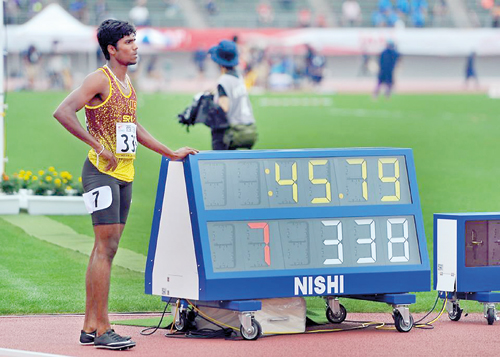400metre sprinter Aruna is capable of bigger deeds

On his way to 400m gold
Over the past two decades, Sri Lanka has fallen into a state of sporting mediocrity without even realising it. Poor performances have been embraced rather than being culled by the authorities.
Cricket, a favourite sport, is now at its lowest ebb in Sri Lanka. The reasons are well documented and range from a low quality feeder system to imprudent handling of cricket affairs by those in power. And, yet, the players were recently rewarded with a 34 percent salary increase.
Then, take athletics, a sport Sri Lanka has periodically excelled at. With an Olympic medal, two world championships medals and a rich haul of Asian level medals in the late 1990s and early 2000s, Sri Lanka was once formidable on the track–something relatively affluent neighbour, India, could not boast at the time.
But the islanders lost its grip in the region with the retirement of the “famous four”–Susanthika Jayasinghe, Damayanthi Darsha, Sriyani Kulawansa and Sugath Tilakaratne–towards the end of the last decade. And the administrators did not place emphasis on grooming new talent to fill the void they left.
The failure to nurture fresh talent has had far-reaching impact with hundreds of local athletes giving up even before reaching their full potential. Sri Lanka is yet to win even an Asian Games medal since Susanthika Jayasinghe bagged her last international medal (a 100m bronze at the World Championships in 2007).
Sri Lanka has, in fact, featured in every international meet held thereafter. This includes the Asian Games, Commonwealth Games, Olympics and World Athletics Championships. Nobody, however, has had the impact those sprint greats had during their illustrious careers.
But there has been a steady stream of talent emerging, purely through the passion and dedication of these athletes and coaches. They have been toiling with minimum facilities but the absence of the type of support system that their counterparts enjoyed in the 90s has forced many to give it all up for greener pastures. The nine-medal haul–three gold, four silver and two bronze–at the recent Asian Junior Athletics Championship speaks volumes for what is in store if the talent is properly cultivated. What is needed is a strong support system.
In Anura Darshana, Sri Lanka has a champ in the making. At 19, he became the youngest to break the 46secs mark when he clocked a championships record of 45.79secs in the 400m dash. There are signs he could be Sri Lanka’s next big thing in athletics. Only Tilakaratne, Rohan Pradeep and Prasanna Amarasekera have better timings than this youngster in the 400m dash than. The question is do we have a structure that imparts the right guidance and training in a professional environment to help him reach full potential?

Darshana established a new Asian Junior Championships meet record in Gifu, Japan.
Still raw, Darshana is from a family of five brothers and a student of Weerakkeppetipola National School, Akuramboda, in the Central Province. He is trained by Asanka Rajakaruna, the school’s physical training instructor. It is not certain whether Rajakaruna has the knowledge or experience to hoist Darshana to the next level. And whether, if he isn’t capable, he would let Darshana explore other avenues.
Athletics Chief Maj Gen (Rtd) Palitha Fernando says the athlete refused a stint abroad saying he wanted to continue training with his local coach. “He prefers to train here,” he related. “So all we can do now is to monitor his progress and to support him in whatever way we can. In the meantime, we need to do a scientific study on him to understand his strengths and weaknesses and to see what we should do to take him to the next level.”
Given his personal best performance, he is among the world’s top eight juniors–behind four Jamaicans and three American sprinters who had recorded better timings than him–and could even make a possible podium finisher at the World Juniors in Finland next month.
“If you look at the world juniors, he is among the top five,” said Gen Fernando. “If you analyse his race in Japan, he reserves lots of energy towards the end. This means he will definitely record a far better timing than what we achieved in Japan. So I am confident he will make a podium finish in Finland.”
No Sri Lankan has ever won a medal at World Junior Athletics Championships even though Susanthika Jayasinghe did twice at the senior level.
Darshana is not the only bright spot. The men’s 4×400 relay quartet of Aruna Darshana, Pasindu Kodikara, Ravishka Indrajith and Pabasara Niku produced a stunning performance to win gold in an impressive 3.08.70secs. “We also have very good relay team and we are looking to get them a sponsorship so that they can continue in their athletics careers,” Gen. Fernando said.
Sri Lanka has finally found another group of potential athletes. It is hoped now that those administrator levels are not going to satisfy themselves with subpar performances but will start addressing the core issues they face. It’s time to get our athletes hungry for success again and to give them the opportunities they are now deprived of.


